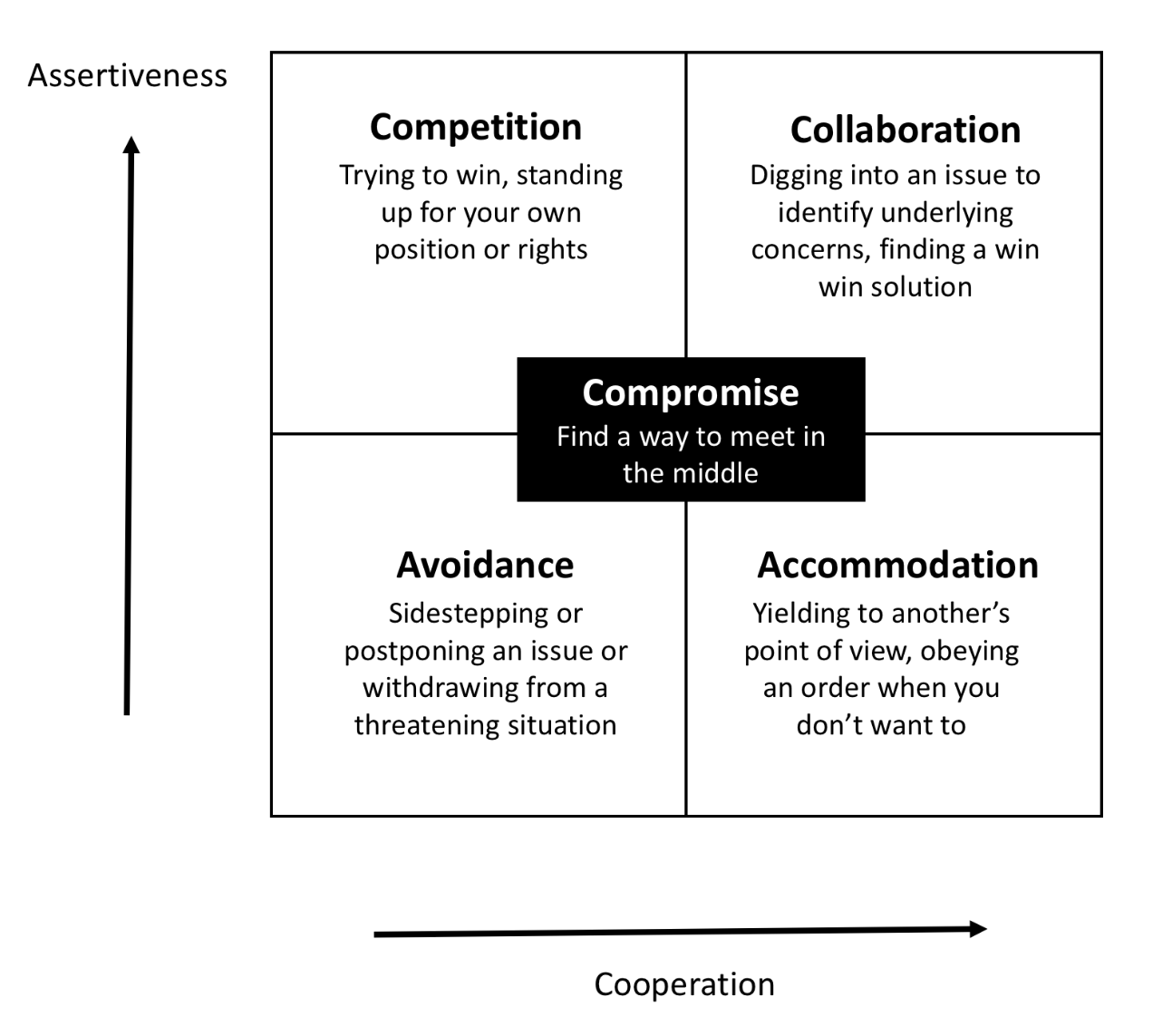Thomas-Kilmann Model
Table of contents
- The Thomas-Kilmann Model
- How to be assertive and cooperative?
- Five behavioral strategies: Avoidance, Competition, Collaboration, Accommodation, Compromising
- When should one avoid, compete, collaborate, accommodate, or compromise?
Different people behave differently in stressful situations like a conflict. People’s behaviors are influenced by the culture in which they were raised, so when a conflict situation happens people react unconsciously in many cases. To master conflict resolution skills one needs to understand the spectrum of default reactions that people have. This awareness enables one to assess others behaviors more accurately, and consciously select an appropriate conflict resolution approach.
The Thomas-Kilmann Model

Thomas–Kilmann Conflict Model provides a set of behavioral strategies that people use in conflict situations. The model is assumes that there are two primary styles of behavior during a conflict:
Cooperativeness
This happens when one seeks for cooperation and common grounds. Cooperative users know how to listen, they do not impose their own opinions, and care about interpersonal relationships.
Cooperative users usually believe that:
- It is important to consider other people’s needs and values.
- Collaboration is a strength, not as a weakness.
- Collaboration allows them to accomplish their personal goals.
Assertiveness
Assertive users defend their personal interests. They think that any conflict has only two options, either win or lose. They are emotionally stable, assertive, and start or join a conflict.
Assertive users usually believe that:
- It is important to consider their personal needs and values first.
- They need to express their own opinions and views and others are interested in them.
- The community will respect them for expressing their interests, rather than sanction them somehow.
How to be assertive and cooperative?
People learn to what extent they need to be assertive or cooperative throughout their life and those characteristics become part of their identity. These characteristics create the lenses through which they see and interpret the world, and as a result what stories they tell themselves when something happens. These stories cause people to react with particular emotions. To change our emotional reactions we need to change the lenses through which we see the world. It requires practicing different behavioral strategies intentionally.
Prioritizing your own needs. How to be assertive
To be assertive one needs:
- Clearly indicate their position.
- Share with others their needs and values.
- Say “no” if the final results do not meet their needs and values.
Helping others achieve their goals. How to be cooperative
To be cooperative one needs:
- Make the other party communicate their needs and values.
- Proactively listen to others.
- Communicate calmly with compassion and empathy.
Insisting on resolving a conflict without suggesting a solution: How to be assertive and cooperative at the same time
There are some cases when one needs to take care of the other party’s interests but be sure that it actually gets done. In such cases they need to use both approaches at the same time, it implies the following.
- Communicating and persuading through a shared mission.
- Deeply understand the others’ views.
- Know the full context and be involved in the conversations,
- Strive to find the resolution of the conflict, not enforcing your own approach.
Five behavioral strategies: Avoidance, Competition, Collaboration, Accommodation, Compromising
Thomas-Kilmann Model defines five behavioral strategies that are based on the two primary styles of behavior.
-
Avoidance. A strategy when a user avoids a conflict neither agreeing with others, nor infuseing their own views. Usually it’s caused by the fear of rejection. Sometimes the fear is so strong that the user cannot bring themselves to even try asking for what they need. It is a lose–lose scenario. The user loses because they do not have a feasible option to make any changes important to them. The community loses because the user will leave the site as soon as they feel that their needs are not met.
-
Competition. A strategy wherein a user secures their needs without considering any option for cooperation, even if it happens at the expense of others. If they get a “no” or encounter resistance, they only intensify the pressure. This results in a win-lose scenario when the user wins but at the expense of others.
-
Collaboration. A strategy when a user makes a dedicated effort to resolve an issue in the way that works for everyone involved. This represents a win-win situation.
-
Accommodation. A strategy when, even though a user can formulate what they need and ask for it, they are ready to give up their interests when facing any even minimal resistance from the other side. This is a lose-win scenario, where the user ends up compromising their own interests.
-
Compromising. A strategy when parties involved gradually give up on certain things they need until they arrive at some end that seemingly works for everyone. This is a win-lose-win-lose scenario.
When should one avoid, compete, collaborate, accommodate, or compromise?
Each strategy has its own pros and cons. Effective conflict management is about being able to choose the right strategy for a given situation and use it correctly.
- Avoid when emotions are heated and an immediate reaction can only make the situation worse.
- Compete when you have more experience and knowledge about the topic or in cases when a fast decision is needed.
- Accommodate when unity of the group and interpersonal relations are more important than a specific result or when you have less experience and knowledge about the topic.
- Compromise when you and the other party need a quick solution.
- Collaborate in all other situations. This is the most productive way to resolve a conflict.